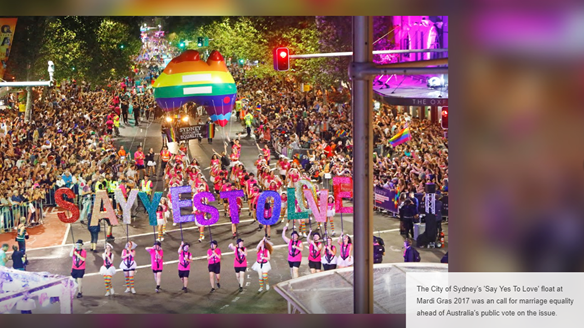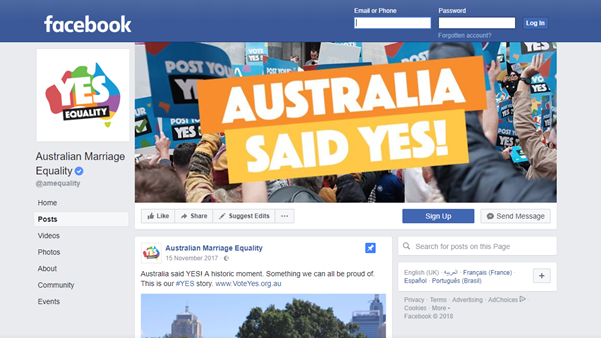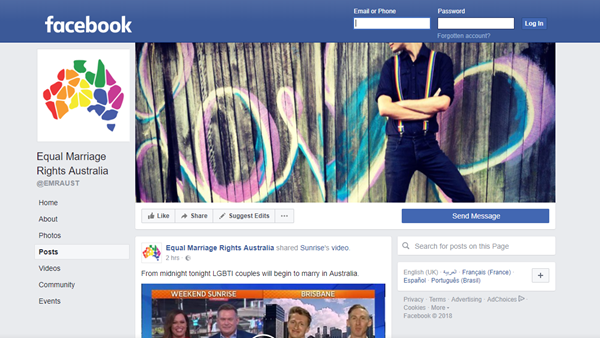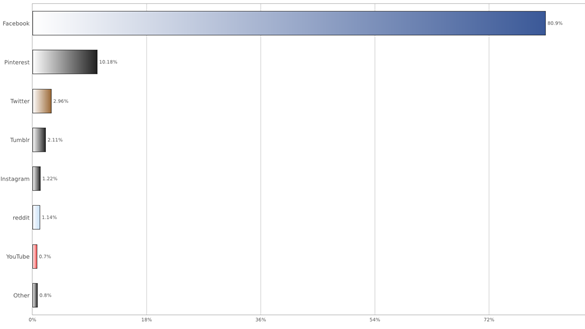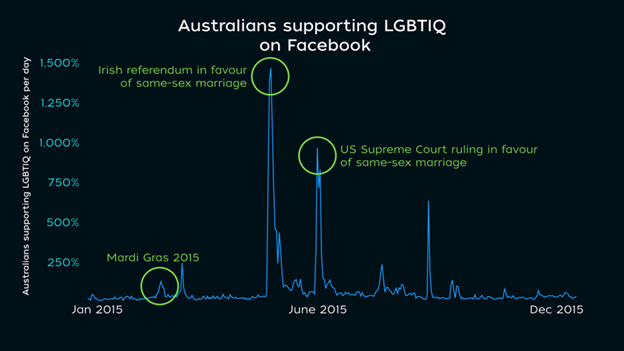LGBT Community: A Multi-Platform Communication Strategy
- OVERVIEW
LGBT community in Australia has unique communicative ecology. As discussed in an earlier report (Task # 3), LGBT community has a long history of mainstream alienation, discrimination, harassment and hostility. Despite a recent national vote for gay marriage equality, a right supported by similar wins in established democracies, LGBT community participates still in public engagements in what could be characterized as “enclaves” defined by LGBT experience. This broad communicative ecology informs how current communication practices are performed by LGBT community and sympathizers.
There are, in fact, several communication platforms, or channels, via which LGBT community engages for different public and private matters. Notably, social media platforms have come to be increasingly significant (virtual) space for LGBT community, an adoption which is consistent to national and global patterns of social media adoption as effective platforms for professional and social purposes. Offline platforms represent, however, historical venues which LGBT community has long used to launch specific initiatives, call for action, organize, highlight and commemorate LGBT events or simply to celebrate. Indeed, while web-based platforms, particularly social media, receive much attention as universal and effective communication channels, conventional, offline platforms, particularly ones used and promoted by LGBT community in Australia, are of no less significance, if impact. In either case, communication channels remain a central component of any communication strategy for any virtually- or conventionally-organized community.
Informed by community’s communicative ecology in Task # 3, current project assesses and recommends most optimum communication channels for LGBT community in Australia. The assessment and recommendations account for context-specific and general communication practices of LGBT community in Australia. This paper aims, hence, to build on LGBT communicative ecology in Task # 3 in order to propose an integrated LGBT communication strategy including most optimum communication channels.
This paper is made up of four main sections in addition to Overview: (1) LGBT Community in Australia, (2) LGBT Community: A Multi-Platform Communication Strategy, (3) Limitations & Recommendations and (4) Conclusion. The “LGBT Community in Australia” section offers a statistical brief on LGBT community in Australia. The “LGBT Community: A Multi-Platform Communication Strategy” section offers a detailed communication strategy for LGBT community in Australia. This section includes discusses specific LGBT communication strategy components, including multiple communication channels. The “Limitations & Recommendations” section discusses existing and possible limitations and offers recommendations for better practice. The “Conclusion” section wraps up main argument and offers insights into possible future directions.
- LGBT COMMUNITY IN AUSTRALIA
The LGBT community in Australia is diverse and cuts across different social, professional and age groups. Unfortunately, no comprehensive, public data is available about overall LGBT community in Australia. The number of same-sex couples has reportedly, however, more than tripled between 1996 and 2011 with around 6,300 children living in same-sex households. The estimates of intersex populations are even less firm but, according to Organization Intersex International Australia (OII Australia), an acceptable figure is 1.7% of all births in Australia. Generally, same-sex couples are likely to be more highly educated, to work in highly skilled professions and to have higher incomes (“Face the facts,” n.d.).
This overall picture, albeit not particularly conclusive, highlights LGBT community’s high public visibility. Moreover, being more educated, more skilled and of higher income offers an interesting demographic detail which informs proposed communication strategy and is discussed in further detail in subsequent sections.
III. LGBT COMMUNITY: A MULTI-PLATFORM COMMUNICATION STRATEGY
This is section, central to current project, offers a detailed communication strategy for LGBT community in Australia as follows:
III.I. STRATEGY COMPONENTS
Like all integrated and effective communication strategies, current proposed communication strategy is made up of specific components: (1) Concept, (2) Communication Channels and (3) Development. The “Concept” component discusses strategy’s central focus and underlying rationale. The “Development” component discusses how current proposed strategy, using select communication channels, should be developed. (For current purposes, “Implementation” component remains beyond project’s scope.)
III.I.I. CONCEPT
Historically, LGBT community in Australia has assumed a “celebratory” standing in nation’s public space. By “celebratory” is meant collective and/or individual actions by LGBT community by which specific causes, initiatives or laws are promoted. This celebratory status continues, paradoxically, against recent positive developments including legislation of same-sex marriage in Australasia. Moreover, while LGBT community has already several online and offline communication platforms, solidarity and community consolidation, possibly against an external public enemy, remains central to most, if not all, current LGBT communication platforms. Instead, LGBT community needs to outgrow current celebratory state into a more mature phase by which on- and offline communication platforms are no longer, or at least not exclusively, defined by LGBT as a separate, alienated community but as just another segment of Australia’s mainstream, as opposed to fringe, segments. This should enable LGBT community to prosper and, more importantly, to better engage and be engaged by different social segments beyond celebration. The next subsection discusses in brief how LGBT community could better engage and under “Communication Channels” subsection more detailed account is provided on how LGBT community could communicate effectively across specific platforms in more engaging ways.
III.I. II. DEVELOPMENT
Identity is central to LGBT community in Australia and, in fact, worldwide. For historical reasons, LGBT community in Australia, like all LGBT communities worldwide, has long been profiled and set aside to communicate and perform day-to-day activities in enclaves. This public avoidance, so to speak, has influenced how LGBT community communicates across different platforms. As discussed in next subsection, LGBT community has by and large “carved out” public spaces or venues to advance specific LGBT concerns. This has made LGBT community into a more or less “separate” segment, detached from Australia’s mainstream. The enclave state of communication has, paradoxically, persisted even when using social media platforms, supposedly open platforms for interaction and communication. The conventional and virtual communication platforms appear, upon actual practice, to feed one another in a closed communication loop instead of opening up to further opportunities provided online by social media platforms and offline by growing, albeit not satisfactory, acceptance of LGBT gatherings, at least legally. This detachment is reflected in both conventional and virtual communication channels.
In current proposal, LGBT community needs not only to integrate current communication channels into broader communication counterparts in Australia’s public and virtual spaces but, more importantly, to run conventional and virtual communication channels in parallel engagement of internal and external stakeholders alike. By “parallel engagement” is meant an integration of current communication channels (off- and online) now used by different LGBT communities so as to sustain and optimize message delivery, particularly when no events are highlighted. Indeed, virtual platforms, particularly social media, appear to be inundated by events already conducted offline, when, in fact, social media platforms could be better harnessed year-round to better integrate LGBT community to broader social concerns beyond LGBT ones and, for that matter, celebratory ones.
The parallel engagement practice also refers to how LGBT addresses both LGBT members and non-members. As matters stand, LGBT community appears to be internally focused on LGBT concerns in message delivery, a practice which makes communication a closed-loop effort. Instead, LGBT community should engage both internal and external stakeholders by not only changing message content (i.e. including non-LGBT issues across different channels) but also by engaging more and more of non-LGBT members. Indeed, exclusivity is no longer an effective communication approach in an age witnessing increasing overlaps within and across different communities. (If anything, a similar parallel of LGBT exclusivity could be found in feminist communities based on gender alone.)
The following section explores select communication channels which should enable LGBT community to perform a more effective parallel engagement.
III.I. III. COMMUNICATION CHANNELS
Communication is central to human life. This cannot be overemphasized in an age characterized by constant and immediate communication across multiple channels. The significance of media channels or platforms is, moreover, best discussed under Media System Dependency Theory (MSDT). According to MSDT, a media system is an information system by which information is created, processed and disseminated (Ball-Rokeach, 2010). Thus, in proposing specific communication channels for LGBT community, message delivery to both internal and external stakeholders should be understood as a practice by which information-seeking agents are empowered or not. That is, in seeking to engage internal and external stakeholders in parallel, as noted above, LGBT community needs to emphasize which content should be created, processed and disseminated but also across which communication platforms. The following subsections discuss how select off- and online communication channels could be harnessed for more effective and engaging communication practice.
III.I. III. I. OFFLINE COMMUNICATION CHANNELS
As is consistently noted, offline or conventional communication platforms are historical to LGBT communication practice. Indeed, a growing body of literature emphasizes communities of practice within LGBT communities which either offer care networks for older LGBT members (Hughes & Kentlyn, 2011) or have developed in 2000s in urban areas forming “gay enclaves” in inner cities (Nash & Gorman-Murray, 2014). Two conventional / offline communication channels emerge, accordingly, as of particular significance and effectiveness as communication platforms for LGBT community: Sydney Pride and Sydney Gay and Lesbian Mardi Gras.
Sydney Pride is well-rooted, nationally and intentionally, in LGBT history and causes. An annual event celebrating LGBT identities, Sydney Pride offers a broad range of networking and entertainment activities which all hark back and pay tribute to historical and notable milestones including an iconic Sydney Mardi Gras March in 1978 (“A Word,” n.d.). This platform is, in fact, well documented, witnesses high participation and, interestingly, has Twitter as platform’s only social media presence.
The platform, however, needs to outgrow current celebratory status into more further engagement with broader social issues. An effective parallel engagement entails not only internal (LGBT) but also external (non-LGBT) stakeholders. As matter stand, Sydney Pride appears to be an infotainment platform offering celebratory services for LGBT community (exclusively). This is evident in platform’s only official online presence, i.e. Twitter, a platform usually used for quick announcements or simply selling (a commercial, social or political product). The platform does not have a Facebook official presence, although Facebook is Australia’s premier social networking platform (see Figure 4 in Appendix).
However, Sydney Pride remains a viable communication channel for LGBT community. Given channel’s strong connections to LGBT community, whether via funding or social opportunities, Sydney Pride could be even more enhanced by introducing additional events highlighting broader social concerns. These events could also be coordinated with similar platforms (including, Sydney Gay and Lesbian Mardi Gras, discussed shortly) to better enhance delivered message across different platforms, better in parallel. (Further recommendations are discussed under “Limitations & Recommendations” section.)
Sydney Gay and Lesbian Mardi Gras is a second viable conventional / offline communication channel for LGBT community in Australia. If anything, Sydney Gay and Lesbian Mardi Gras is Australia’s most iconic LGBT event / platform which has a June-24th-1978 March as a historic milestone. The platform is also well connected to similar international LGBT communities, movements, initiatives or events including, most notably, international Gay Solidarity Celebrations, Gay Solidarity Group, National Homosexual Conference and San Francisco’s Gay Freedom Day (“History,” n.d.). Unlike Sydney Pride, Sydney Gay and Lesbian Mardi Gras has more enhanced social media presence including Facebook, Instagram and Twitter. However, Sydney Gay and Lesbian Mardi Gras remains largely celebratory in nature and includes what amounts to infotainment content whether in actual, physical events or across different digital platforms. (See Sydney Gay and Lesbian Mardi Gras 2017, Figure 1 in Appendix.)
To enact an enhanced parallel engagement practice, Sydney Gay and Lesbian Mardi Gras needs to develop social partnerships beyond current sponsor-partner partnerships. This should not only expand on platform’s public profile but also, more importantly, further integrates Sydney Gay and Lesbian Mardi Gras into Australia’s mainstream public space, beyond exclusivity. (Further recommendations are discussed under “Limitations & Recommendations” section.)
III.I. III. II. ONLINE COMMUNICATION CHANNELS
The social media sphere receives, one does not need to re-emphasize, broad attention in LGBT media production and consumption literature. Informed by MSDT, media production and consumption of LGBT community is examined as part of community’s evolving identity management process (Cassidy, 2013; Morton & Duck, 2000). Two LGBT communities enjoy sizeable fan base on Facebook: Australian Marriage Equality (Australian Marriage Equality, n.d.) and Equal Marriage Rights Australia (Equal Marriage Rights Australia, n.d.). (See Figure 2 and Figure 3 in Appendix for Facebook pages of Australian Marriage Equality and Equal Marriage Rights Australia communities, respectively.)
For current purposes, Facebook is recommended as third communication channel for LGBT community. This can be justified based on serval rationales. If anything, Facebook is not only Australia’s premier social networking platform (Cowling, 2017) but also appears to be LGBT community’s most preferred social media platform to reveal acts of coming out (“Facebook reveals more Australians coming out,” 2016). (See Figure 4 in Appendix on comparative weight of social media platforms in Australia.). Moreover, Facebook appears to be an ideal platform, probably for platform’s multiple sharing features compared to different social media platforms, via which LGBT communities worldwide could drive interests in specific pages during specific LGBT-related events. (See Figure 5 in Appendix on recent spikes in Australian user’s support for LGBT events.) Interestingly, Australian LGBT pages on Facebook, similar to LGBT ones in different countries, are of an international appeal (Cowling, 2017). This makes Facebook a particularly viable communication platform for LGBT community by enabling message creation and development beyond specific, country-based communities.
To be an effective communication platform, Facebook presence for LGBT community should consider for specific usability habits for one or more fan bases in different countries. More specifically, while Facebook, just like all web platforms, is international in nature, developing and delivering messages such as to match fan base usability habits and preferences ensures messages are properly received and, more importantly, responded to in ways which ensures delivered messages have made desired impact. Targeting morning and night hours for Australian users ensures, for example, recipients are online and more likely to interact (Digital360. (2017).
- LIMITATIONS & RECOMMENDATIONS
There are, overall, some limitations as to how proposed communication channels would result in desired parallel engagement objectives. First, LGBT identities are, after all, fluid and continue to evolve. This makes accurate message channelling elusive. Second, LGBT community is a diverse, fragmented one, a characterization which should be considered in order to balance out considerations for overall community’s unity and specifics of each sub-communities. Third, just as LGBT identities are fluid and continue to evolve, so are chosen communication channels. This requires constant engagement with different communities not only to updated chosen communication channels but probably to launch and/or choose new ones which better address evolving community needs.
In better enhance chosen communication channels, a number of recommendations might be considered. Sydney Pride is recommended, for example, to expand on events offerings beyond current entertainment ones. These could include public speaking events in select venues and/or experience-sharing workshops or seminars in more formal manner compared to current “social networking” activities which are performed, or not, during concert events. Sydney Pride is also recommended to expand on social media presence beyond Twitter for broader reach. For Sydney Gay and Lesbian Mardi Gras, partnerships should go beyond current sponsorship ones and into more social ones. Examples include engaging non-LGBT influencers to invest in Sydney Gay and Lesbian Mardi Gras events. This should, hopefully, further integrate Sydney Gay and Lesbian Mardi Gras into mainstream but, more importantly, makes LGBT community more participatory in broader public causes and events.
- CONCLUSION
LGBT community in Australia remains isolated. Despite recent legal developments and (little) changing social attitudes, LGBT community still depends on enclaves, off- and online, for communication, whether with LGBT or non-LGBT members. This paper proposes a multi-platform communication strategy for LGBT community in Australia. Three communication channels are proposed: Sydney Pride, Sydney Gay and Lesbian Mardi Gras and Facebook. Current communication practices in each channel are briefly discussed, improvements suggested, and recommendations made. Overall, LGBT community needs to outgrow current celebratory status into a more responsible, socially-oriented phase by engaging both internal and external stakeholders using proposed communication channels.
APPENDIX
Figure 1. LGBT community parades in support of a “Yes” vote on marriage equality during Sydney Gay and Lesbian Mardi Gras 2017 ahead of Australia’s national vote (Calilhanna, 2017)
Figure 2. Australian Marriage Equality page on Facebook. (Luo, Zheng, Pyo & Zheng, 2018a)
Figure 3. Equal Marriage Rights Australia page on Facebook. (Luo, Zheng, Pyo & Zheng, 2018b)
Figure 4. This chart shows comparative weight of each major social media platform in Australia. (StatCounter, n.d.)
Figure 5. This chart shows support for LGBT community on Facebook, particularly during specific events. (Facebook, 2016)





